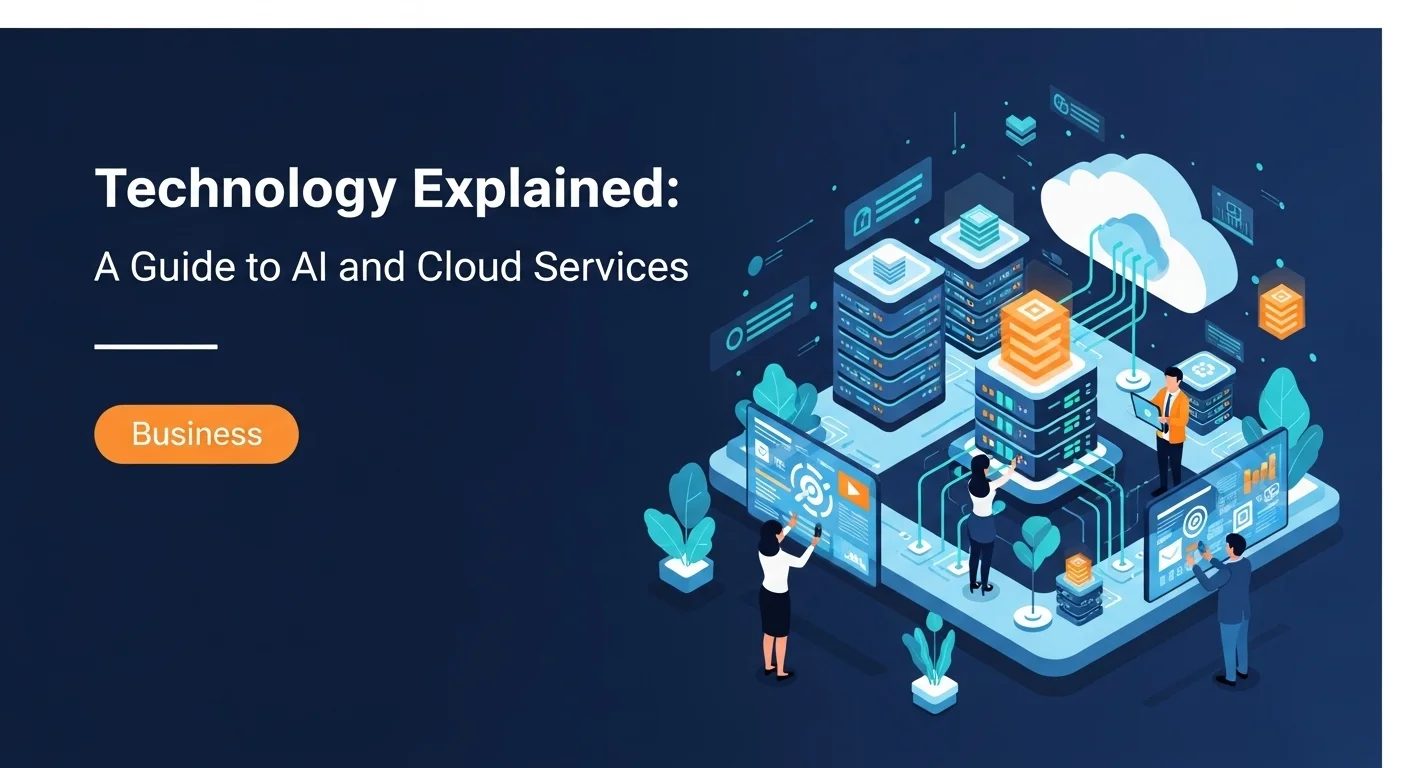Build Your Future: A Founder's Guide to Starting a Tech Business

Executive Summary
In our digital world, launching your own venture is about more than just starting a business—it's about taking control of your future with technology. I've spent years in the trenches with startups, and I've seen firsthand how this guide can be your roadmap. We'll walk through the game-changing technologies that make it all possible today: Artificial Intelligence (AI), cloud computing, and cybersecurity. You'll get real, actionable ideas for building a company from the ground up. Whether you're aiming to create an online business or a groundbreaking tech service, this is where you start. We'll cover everything from your initial spark of an idea to choosing the right tech, locking down your security, and using data to grow. My goal is to empower you to not just launch, but to build a resilient and successful tech company. This is your starting point for turning a passion for technology into a profitable reality.
Table of Contents
- What Does It Mean to 'Start Your Own' in Tech Today?
- Business Applications and Real-World Benefits
- Exploring Initial Ideas and Overcoming Challenges
What Does It Mean to 'Start Your Own' in Tech Today?
The idea of 'starting your own' has been completely transformed by technology. It's not just about registering a company anymore; it's a mindset of creating and owning your work in the digital world. In my experience, the shift from being a user of technology to becoming an architect of it is one of the most exciting trends of our time. It gives anyone the power to solve problems, create value, and truly design their own path. If you're dreaming of building a company from your home office, technology offers the most direct and scalable way to get there.
Three pillars have completely changed the game for aspiring founders: cloud computing, artificial intelligence (AI), and solid cybersecurity. Together, they've dramatically lowered the cost and complexity of starting a business, making it possible to launch a global company with little more than a laptop. Cloud platforms like AWS and Google Cloud give you instant access to massive computing power without buying a single server. I remember when startups needed tens of thousands of dollars for hardware; now, you can pay as you go. This flexibility is what allows you to build an online business with the same powerful infrastructure as a Fortune 500 company.
Artificial Intelligence is the other great equalizer. What used to be confined to university research labs is now available through simple APIs. This means you can integrate powerful features like language translation or image analysis into your app with surprising ease. It blows the doors wide open for new business ideas, from AI-powered marketing tools to intelligent customer service bots. The recent explosion in generative AI, for instance, lets a small team create content, write code, and personalize user experiences at a level that once required huge departments. It's a massive force multiplier for entrepreneurs.
Business Applications and Real-World Benefits
So, where can you apply this mindset? One of the most common paths I see founders take is creating a Software as a Service (SaaS) company. You build a solution for a specific problem—like project management for designers or financial planning for freelancers—and sell it as a subscription. The beauty of SaaS is the recurring revenue and the ability to scale to a global audience from day one. E-commerce is another huge area. Even with big players out there, there's always room for specialized stores, clever plugins, or niche marketplace platforms. These are perfect examples of how you can build a business from home and serve customers anywhere in the world.
Beyond building products, the demand for expert tech consulting is through the roof. Every company, big or small, needs help with their digital strategy, cloud setup, or security. If you have the knowledge, you can build a very profitable consultancy. For instance, with cyberattacks on small businesses constantly in the news, starting a cybersecurity consulting firm is one of the most relevant business ideas today. The stats are clear: nearly half of all cyber breaches hit companies with fewer than 1,000 employees, creating a massive need for affordable expertise.
Of course, the benefits go beyond money. The true reward is autonomy—the freedom to be your own boss, set your own schedule, and make your own calls. For many founders I've mentored, that flexibility is life-changing. There's also an incredible sense of fulfillment that comes from building something from scratch and seeing it solve a real problem for people. It's a chance to blend your passion with your work and make a tangible impact. It's a tough road, but it offers a direct path to creating a life on your own terms.
Exploring Initial Ideas and Overcoming Challenges
Every great venture starts with an idea, and this phase can be both thrilling and terrifying. The trick is to find where a market need, your own skills, and a viable business model overlap. Honestly, the best ideas often come from your own frustrations. What process at your job is a pain? What service in your daily life could be done better? Those are goldmines for business concepts. For example, the massive shift to remote work created demands for better collaboration software, stronger home network security, and virtual team-building services. The home automation space is also booming, with opportunities for everything from custom installations to new smart devices.
Before you dive in, you have to do your homework. Market research isn't optional. Use tools like Google Trends or just browse social media to see what people are talking about and searching for. Look at your potential competitors. What do they do well? Where are their blind spots? Your goal is to find your unique angle—the reason someone would choose you. It doesn't have to be a revolutionary, world-changing idea. Some of the most successful businesses I've seen were built on simply improving an existing concept.
Let's be real, though: it's not an easy path. In the beginning, you'll be doing everything—CEO, developer, marketer, and customer support—all at once. Funding can be a major hurdle. While many tech businesses can be started with personal savings, growth often requires outside investment. You'll need to learn about your options, from investors to crowdfunding. The relentless pace of technology is another challenge; you have to be a lifelong learner. Finally, the isolation of working from home can be tough. Building a network of mentors and peers is not a luxury; it's essential for your sanity and your success. Overcoming these obstacles is what forges you into a resilient and capable founder.

Your Complete Guide to Launching a Tech Business
Turning a tech idea into a real business requires a solid game plan. I've built this guide to give you a clear, step-by-step roadmap that covers both the technical details and the business strategy. This is for the entrepreneur who's ready to stop dreaming and start doing. We'll focus on practical methods and critical choices to help you build your venture from the ground up.
Phase 1: From Idea to a Working Foundation
The first step is to sharpen your business idea into a concrete plan by defining a Minimum Viable Product (MVP). An MVP is the simplest version of your product that delivers real value to your first users. I can't stress this enough: this approach lets you launch fast, get feedback from actual customers, and adapt without burning through your savings. The whole 'Build-Measure-Learn' cycle is the heart of a lean startup, and it's your best defense against building something nobody wants.
With your MVP defined, you face a critical decision: your technology stack. This is the set of tools you'll use to build your product. Here’s how I break it down for founders:
- Front-End (What the user sees): Frameworks like React, Angular, and Vue.js are the leaders here. The right choice depends on how complex your app is and your team's skills.
- Back-End (The engine): This is where your app's logic lives. Node.js is great for real-time features, while Python is a powerhouse for anything involving AI and data.
- Database (Where your data lives): You'll generally choose between a structured SQL database (like PostgreSQL) for reliability or a more flexible NoSQL database (like MongoDB) for handling varied data types.
- Low-Code/No-Code Platforms: If you want to launch an online business without being a coding expert, platforms like Bubble or Webflow are revolutionary. They let you build powerful apps with visual tools, which is a massive shortcut.
At the same time, you need to build on the cloud. AWS, Azure, and Google Cloud are the giants for a reason. Their free tiers and startup programs are a gift, offering credits and support to get you going. You'll want to get familiar with their core services for computing, storage, and databases. I often advise startups to consider a 'serverless' approach, where the cloud provider manages the infrastructure. It saves you time and money, which are your most precious resources.
Phase 2: Building a Real Business and Locking It Down
With your tech plan solidifying, it's time to make your business official. This means choosing a legal structure like an LLC, registering your name, and getting the right permits. It's not the glamorous part, but skipping this step is a rookie mistake. A quick consultation with a legal professional can save you a world of headaches later.
Cybersecurity is not an add-on; it's a foundation. I've seen promising startups get wiped out by a single data breach because it destroys customer trust. For any online venture, security must be built-in from day one. Here are the absolute must-haves:
- Secure Development: Build security into your coding process. This means reviewing code, scanning for vulnerabilities, and following best practices from the start.
- Data Encryption: All sensitive data—whether it's stored in your database or traveling over the internet—must be encrypted. There's no excuse for not doing this.
- Access Control: Use strong authentication like multi-factor authentication (MFA) for everyone. Give people access only to the systems they absolutely need to do their job.
- Have a Plan for When Things Go Wrong: An incident response plan is your fire drill for a cyberattack. Know exactly what you'll do to detect, contain, and recover from a breach.
- Cloud Security is a Shared Job: Your cloud provider secures the cloud, but you are responsible for securing what you *build on* the cloud. This means correctly configuring your firewalls, access controls, and permissions. This is a critical responsibility for every founder.
Phase 3: Launch, Marketing, and Smart Growth
Your launch should be just as carefully planned as your product. A 'soft launch' with a small group of users is a great way to find bugs and get early testimonials. When you go public, you need a marketing push. For a tech startup, your lifeblood is digital marketing:
- Content Marketing: Write blog posts or create tutorials that actually help your target audience. This builds trust and brings in traffic through search engines over the long term.
- Search Engine Optimization (SEO): Make sure people can find you on Google when they search for solutions to their problems. It's a long game, but the payoff is sustainable growth.
- Paid Ads: Use platforms like Google Ads to get in front of your ideal customer quickly. It's perfect for getting initial traction and testing your message.
- Social Media: Build a community where your audience hangs out. For tech, places like LinkedIn, Twitter/X, and Reddit can be incredibly powerful.
Once you have users, you need to become obsessed with data. Use analytics tools to understand how people are using your product. Where do they get stuck? What features do they love? This data is your guide. It should drive your decisions, not gut feelings. Constantly talk to your users. Their feedback is the most valuable asset you have. This cycle of listening, learning, and improving is the engine that will power your growth from a simple idea to a thriving technology business.

Advanced Tips to Sharpen Your Tech Venture's Edge
Starting a business from home is a marathon, and long-term success comes from working smart. I've seen countless founders succeed by adopting the right strategies, using the best tools, and never stopping learning. This section is about those next-level tips that help you build a resilient and efficient company that can truly compete.
Adopting Best Practices for Sustainable Growth
To build a business that lasts, you need discipline. These are the methodologies I've seen work time and time again to help founders build the right thing, manage their resources, and stay ahead.
- Embrace Agile and Lean: Forget rigid, long-term plans. Work in short cycles, or 'sprints,' to deliver value quickly and adapt to change. The 'Build-Measure-Learn' loop is your best friend—it stops you from wasting years building a product no one wants to pay for.
- Obsess Over User Experience (UX/UI): A product that works isn't enough anymore. It has to be intuitive and enjoyable to use. I've seen apps fail for this reason alone. Invest in good design from the start. A seamless user experience can be your most powerful weapon.
- Build a Data-Driven Culture: Every major decision should be backed by data. Track the key metrics that matter for your business, like how much it costs to get a customer (CAC) and how much they're worth over time (LTV). Data takes the emotion out of decision-making and leads to better results.
- Build for Tomorrow's Growth: It's tempting to build something quick and dirty for today, but you have to think about the future. Design your technology to scale. This means choosing a flexible cloud architecture and writing clean code. Trust me, fixing a poorly designed system later is a nightmare you want to avoid.
- Commit to Ethical Tech: Trust is everything. Be transparent about how you use data, protect user privacy, and think about the impact of your technology. If you're working with AI, you have a responsibility to address potential biases. An ethical foundation isn't just a nice-to-have; it's good business.
My Go-To Toolkit for Business and Technology
Running a tech business from home is only possible because of the incredible tools available today. Using the right ones will save you countless hours and let you focus on what really matters.
- Project Management: Tools like Asana or Trello are non-negotiable for keeping tasks organized and making sure nothing gets missed.
- Communication: Slack or Microsoft Teams are essential for real-time collaboration and cutting down on endless email chains.
- Customer Relationship Management (CRM): Once you have customers, a CRM like HubSpot is vital for managing your sales and marketing. Their startup program offers great discounts.
- Code Management & Deployment: GitHub is the standard for managing your code. Setting up an automated pipeline (CI/CD) to test and deploy your code saves time and prevents errors.
- Cybersecurity Tools: Use a web application firewall (WAF) from a service like Cloudflare and run vulnerability scanners. These are your digital security guards.
- Home Office Tech: If you're building a business from home, your workspace matters. Invest in fast, reliable internet (with a backup!), an ergonomic chair, and good lighting. It’s an investment in your own productivity and health.
Staying Sharp and Tapping into Resources
Technology moves at a dizzying pace. You have to commit to being a lifelong learner. I dedicate a few hours every week just to staying informed.
- Follow the Right News: Publications like TechCrunch and blogs like Stratechery provide sharp analysis of what's happening in the industry.
- Join the Conversation: Communities like Indie Hackers and specific subreddits are amazing places to learn from your peers and get honest feedback.
- Never Stop Learning: Use platforms like Coursera or freeCodeCamp to pick up new skills, whether it's a new programming language or the basics of digital marketing.
- Listen to Podcasts: Shows like 'How I Built This' and 'Acquired' are a masterclass in business and technology that you can listen to anywhere.
- Find a Mentor: Connect with someone who has already walked the path you're on. A good mentor can help you avoid common mistakes and open doors you didn't even know existed.
By making these strategies and tools a part of your routine, you drastically increase your chances of success. Building your own tech company is a journey that rewards preparation, resilience, and a relentless focus on creating value. It's about building not just a product, but a business that can adapt and thrive for years to come.
Expert Reviews & Testimonials
Sarah Johnson, Business Owner ⭐⭐⭐
Good overview, but as a small business owner, I was hoping for more step-by-step examples I could apply directly.
Mike Chen, IT Consultant ⭐⭐⭐⭐
Solid article that connects the dots between tech trends and business opportunities. A great starting point.
Emma Davis, Tech Expert ⭐⭐⭐⭐⭐
This is one of the best guides I've read. It's comprehensive, clear, and genuinely helpful for anyone serious about building a tech company. Fantastic work!



